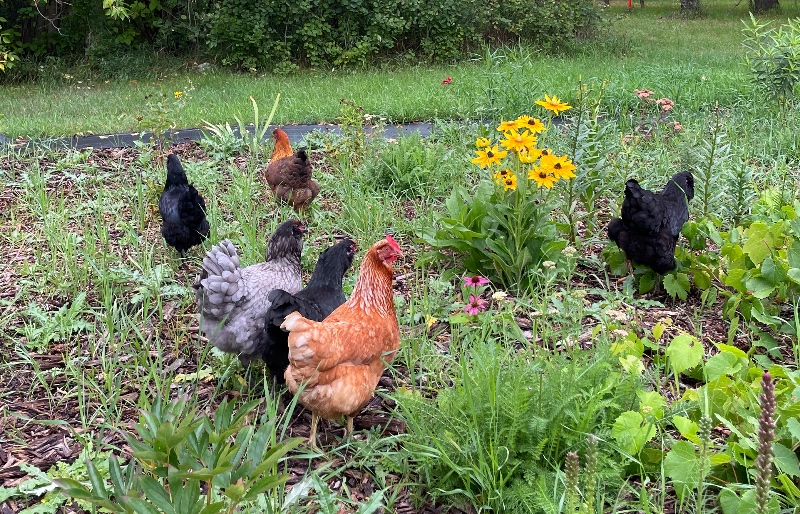When I first began hatching chicks to increase my flock of laying hens, one of my biggest questions was how to tell the roosters from the hens. I really didn’t want to feed tons of roosters that I wasn’t keeping all summer, spending more money than necessary on feed. But I just couldn’t figure out who was who, even after reading a bunch of posts on the Internet about it. So I let them live until it became glaringly obvious and we later culled them and used them as chicken stock.
After raising baby chicks a few times, I’ve now come up with 3 reliable ways to tell a rooster from a hen that work even for barnyard mixes. I’ll also discuss some other methods that are for more advanced chicken keepers.

Watch their Behaviours Closely
Once you’ve hatched your chicks and they’ve passed through the first week of being super sleepy little chicks, start watching their behaviours. Roosters tend to be the ones who are the first to jump on the waterer, roost on the edge of their box, and jump out of the box and try and find you down the hallway. Your hens will eventually do these things, they will just take longer to figure them out.
Depending on the weather, we usually move our chicks out of the house after the second or third week. Once you move them to the coop outdoors, watch and see if any of your chicks start facing off with each other. These chicks are roosters.
Some roosters will start facing each other off around that 3 week mark, while some of my other roosters didn’t start doing it until around the 12 week mark.
While you might have the occasional hen who is first to jump on the waterer, I’ve never seen two hens face off in that manner.

Pretty Chicks Are Usually Roosters
While it’s more difficult to determine the typically male and female patterns on chicks with barnyard mixes, in some purebred breeds it’s very simple to tell the hens from the roosters. For example, if it’s a breed with lines on the feather pattern, the lines will be darker.
At around 2 weeks, roosters will have developed less wing feathers and no tail feathers, while hens will have more wing feathers and small tail feathers developing. This method is about 80% accurate, but another easy one to spot.
As the chicks grow up, you’ll notice that some chicks start to grow very colourful feathers, especially around their tail. They’ll also have longer tail feathers than the hens, and those tail feathers will droop down.These chicks will very likely become roosters.
However, this is not entirely reliable, as you will have the odd rooster, especially with barnyard mixes, that doesn’t look very pretty or the tail feathers don’t do what you’d expect. There was one grey rooster I was convinced was a hen until I saw it face off with another rooster and heard it crow.

Roosters Crow, Hens Lay Eggs
If all else fails, you will know without a doubt whether you have a rooster or a hen on your hands when it either starts to crow or lay an egg.
Don’t confuse crowing with a hen singing her egg song!
A rooster crowing will sound similar to the sterotypical cock-a-doodle-doo, but an egg song will sound more like bock-bock-bock.
Also, roosters tend to start crowing around 16-20 weeks, (4 or 5 months) and hens will start laying eggs around 16-24 weeks (4-6 months). This is determined by breed type, and for hens, can take longer if they come to maturity in late fall when the days are significantly shorter.
One thing that I didn’t know as a beginner chicken keeper, is that roosters will crow all day long, not just in the morning. Each rooster has a specific crow, and it can be quite annoying when you have 12 of them singing at all hours of the day!!
A hen will sing her egg song before or after she is about to lay an egg. During the summer when my free range hens sometimes lay outdoors, I use their egg songs to try and figure out where their clutch is.

Experience is an Excellent Teacher
The first time you hatch chicks you will likely struggle with feeling confident in who is a hen and who is a rooster. It’s easiest to tell the difference between 16 and 24 weeks of life. But over time you will see the different signs quicker and know what you’re looking for.
Now that we’ve discussed the easiest ways to tell chicks apart, let’s discuss some other ways that are not as beginner friendly.
Watch for These Signs of a Rooster As it’s Growing
While crowing, longer tail feathers, and facing off with each other are more beginner-friendly signs to look for, there are lots of other giveaways.
Roosters will develop combs and wattles faster, have thicker legs, and the aforementioned longer tail feathers that eventually droop. Males will also generally be larger in size than females.
Males can develop more pronounced spurs on their legs, but all chickens have them, and it’s not uncommon for females to develop full spurs too.
Finally, there is a method of checking for males and females by the size and shape of their vent when they are chicks, but very few people know how to do it correctly and I have heard that it is very disturbing to watch.
While one of these methods on it’s own isn’t foolproof, if you notice multiple signs pointing towards a certain gender, you can be fairly certain of making an ID.
Are there any signs I missed? Let me know in the comments!

